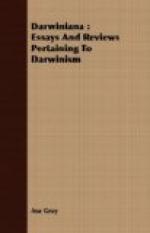Wherefore, when, at the close, you quote Laplace, that “the discoveries of science throw final causes farther back,” the most you can mean is, that they constrain us to look farther back for the impulse. They do not at all throw the argument for design farther back, in the sense of furnishing evidence or presumption that only the primary impulse was designed, and that all the rest followed from chance or necessity.
Evidence of design, I think you will allow, everywhere is drawn from the observation of adaptations and of results, and has really nothing to do with anything else, except where you can take the word for the will. And in that case you have not argument for design, but testimony. In Nature we have no testimony; but the argument is overwhelming.
Now, note that the argument of the olden time—that of Paley, etc., which your skeptic found so convincing—was always the argument for design in the movement of the balls after deflection. For it was drawn from animals produced by generation, not by creation, and through a long succession of generations or deflections. Wherefore, if the argument for design is perfect in the case of an animal derived from a long succession of individuals as nearly alike as offspring is generally like parents and grandparents, and if this argument is not weakened when a variation, or series of variations, has occurred in the course, as great as any variations we know of among domestic cattle, how then is it weakened by the supposition, or by the likelihood, that the variations have been twice or thrice as great as we formerly supposed, or because the variations have been “picked out,” and a few of them pre served as breeders of still other variations, by natural selection?
Finally let it be noted that your element of necessity has to do, so far as we know, only with the picking out and preserving of certain changing forms, i. e., with the natural selection. This selection, you may say, must happen under the circumstances. This is a necessary result of the collision of the balls; and these results can be predicted. If the balls strike so and so, they will be deflected so and so. But the variation itself is of the nature of an origination. It answers well to the




